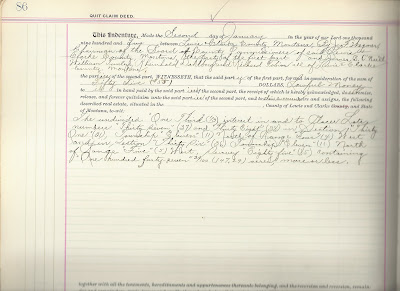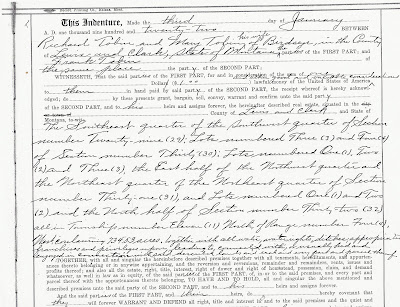Richard Tobin's story starts when he was born October 1848 or 1849 in County Cork, Ireland (no known documentation other than death certificate indicating birth in Ireland in October 1849). Timing of his birth coincides around the time of the "Great Famine in Ireland."
Richard came to America as a young man, and journeyed to Philadelphia, PA. Shortly after he arrived in the United States, he wrote and asked Mary to join him. They were married in Philadelphia.
 |
| Assumption Blessed Mary Virgin (BMV) Church, Philadelphia, PA |
Richard went to work for James J. Hill's railroad, soon to be named the Great Northern, as a section foreman. Several of his children were born while he was working for the railroad as the rails were laid westward (see pages for each child). The family journeyed as far west as Drummond, MT while he was working working for the railroad and decided that it would be best for the family to settle. In 1891, they purchased the property at Birdseye, MT (8 miles from Helena, MT on Seven Mile Creek near the Austin turnoff) and he built the family home (see page for Tobin Ranch).
 |
A photo take by Karylyn Bliss, August 2009, a railroad siding near Fort Harrison and less than a mile from the Tobin ranch house is named after the Tobin family.
|
 |
| Tobin Ranch [photo taken by Karylyn Bliss 17 Jan 2011] |
The Tobin boys would often take the spur railroad to Marysville to a dance on Saturday night and get home in time to do the milking in the morning.
 |
| Richard Tobin [closeup] |
 |
Historically, the Chippewa lived in bands on both sides of the Canadian border and the Great Lakes region. The Tribes began their migrations in the 1700s and 1800s and by the early 1890s had united in a search for a permanent home - a place where children could be brought up in peace, where native religion would be uninterrupted and flourish. In 1916, Rocky Boy's Reservation was established by Executive Order and is located near Havre, Montana, approximately 200 miles north of Birdseye, Montana. The leaders and their people, numbering 450 at the time, had sought refuge in sizable Montana towns, cities, and even other Montana Indian reservations including the Blackfeet, Flathead, and Fort Belknap Reservations. [Reference http://www.rockyboy.org/]
|
In 1904, a man by the name of Ike LaVelle was causing havoc by dynamiting the trains and robbing them. His hideout was close to Birdseye, and when the County Sheriff found out about it, he and his crew came out to capture him. The Tobin boys wanted to help, but Richard wouldn't let them because they were too young. LaVelle was eventually captured at Birdseye and taken to jail in town. When the jailer was taking him to the Courthouse, he escaped by killing his captor. The jailer he killed was the grandfather of Bill Korizek and Helen Kovich from Helena, MT. It was an incident that all the children never forgot.
 |
| Richard Tobin [closeup] |
 |
Left to right: "Hector", Ella Tobin Murray, Richard Tobin, ? [circa 1920s, unknown location]. A special thanks to Justine Tobin for this photo.
|
 |
Richard Tobin [circa 1920s, unknown location]. A special thanks to Justine Tobin for this photo.
|
 |
Richard Tobin [circa 1920s, unknown location]. A special thank you to Justine Tobin for this photo.
|
Richard and Mary continued to live on the ranch after the children were married.
Note: John L. (his son), and his wife "Mugs" and two children "Sis" and "Bud" lived on the ranch also. Both "Sis" and "Bud" were born on the ranch. A special thanks to Jeff Tobin for this information.
Also, Richard D. (his son), took his father, Richard, on a train to Barnes Hospital in St. Louis for tongue cancer surgery [verbal story told to Richard's great-grandson, David Tobin, from his father Richard Donald Tobin Jr.]. A special thanks to Justine Tobin for this information.
Richard died at the age of 78 on March 31, 1927 at St. John's Hospital in Helena, MT. Richard's death certificate lists the principal cause of death as tongue cancer (onset 1 year). Internment is at Resurrection Cemetery, Helena, Lewis and Clark, Montana.
 |
| Document in the possession of Benda Neuenswander. |
Helena Independent Record dated 31 Mar 1927: "Richard Tobin, Sr., for many years a prominent resident of this county, died late last night at a local hospital after a long period of failing health. Mr. Tobin was 79 years of age, a native of Ireland. He is survived by his widow and four sons, Richard, Jr., John and Frank Tobin, of Helena, and William Tobin, of Lewistown, and four daughters, Mrs. E. Murray, of Great Falls; Mrs. R. J. Dilley, of Payette, Idaho; Mrs. Frank Farley, of San Francisco, and Miss Mary Tobin, of Helena. Arrangements for the funeral were not complete last night. Mr. Tobin's body is at Opp and Conrad's funeral home."
 |
Photo taken by Karylyn Bliss, August 2009, near the Tobin railroad siding, looking south towards Helena, MT
|
RESEARCH NOTES:
Passenger Lists: I am currently searching ship passenger lists, microfilms, etc. at the Family History Library (Salt Lake City, UT), and have yet to locate him.
Great Northern Railroad: see additional blog "Great Northern Railroad."
Marriage:
It is my belief that Richard Tobin married Mary Rickerts in Philadelphia, PA. The date and location of their marriage coincides with the family story written by Avis Ann "Sanny" Tobin even though Mary's last name is different. I also believe Mary's last name is Rickerts based on several of the older children's marriage certficates list their mother as Mary Rickerts or Ricketts. Also, the christening certificates of Patrick Tobin and Mary Tobin state their mother's name is Ricketts or Richards. More confusion comes with documents from later children as to their mother's maiden name.
Therefore, for the purposes of this blog, I am assuming Richard's wife's name is Mary Rickerts, as seen on the following documents. Of note, I located these documents via a records search at the LDS Church Genealogy Library [microfilm # is written at the bottom of these documents]. They are entries into a log by the person performing the ceremony for the city of Philadelphia. Noteworthy: After two years of searching marriages for a Richard Tobin around 1880 in all of the United States, this is the only hit I had:
On 8 Jan 2011, I met with Benda Neuenswander [my mother's sister]. I did not tell her about my search for the last two years for the marriage of Richard Tobin. She unknowingly produced the following document, which by the way, coincides with the two log entries listed above.
U.S. Federal Census:
Unable to locate Richard Tobin earlier than 1910
1910 ~ Butler School District, Lewis and Clark County, MT (16 Apr 1910)
Tobin, Richard, head, male, 51, b. Ireland, parents=Ireland, immigrated=46, farmer
Tobin, Mary, wife, female, 30, b. Ireland, parents=Ireland, immigrated=36, house
Tobin, Richard D, son, male, 23, single, b. Dakota, parents=Ireland, conductor, railroad
Tobin, John, son, male 21, single, b. Montana, parents=Ireland, laborer
Tobin, Joe, son, male 13, single, b. Montana, parents=Ireland, house
Tobin, Frank, son, male, 11, single, b. Montana, parents=Ireland, house
Tobin, Mary, daughter, female, 23 single, b. Dakota, parents=Ireland, house
Tobin, Johanna, daughter, female, 8, single, b. Montana, parents=Ireland, house

1920 ~ Clough School District 32, Lewis and Clark County, MT (9 January 1920)
Tobin, Richard, head, male, 68, immigrated 1862, naturalized 1904, b. Ireland, parents=Ireland, farmer
Tobin, Mary, wife, female, 62, immigrated 1864, naturalized 1904, b. Ireland, parents=Ireland, housewife
Tobin, Joe, son, male, 23, single, b. Montana, parents=Ireland, farming
Tobin, Frank, son, male, 21, single, b. Montana, parents=Ireland, farmer
Tobin, Mary, daughter, female, 31, single, b. North Dakota, parents=Ireland, housekeeper
Tobin, Ella, daughter, female, 26, single, b. Montana, parents=Ireland, school teacher

.jpg) |
"Declaration of Intention" #1601 to be come a U.S. Citizen, dated 28 Oct 1902. District Court of the First Judicial District of the State of Montana.
|
.jpg) |
| Death Certificate - State of Montana |
 |
I then searched the PATENTS book (AKA homsteading claims which normally includes 160 acre parcels). I started with the first book and entry for Lewis and Clark County dated in the year 1862. I looked through every entry through 1894 and could not locate a patent for any Tobins through 1894. This means that Richard Tobin did not homestead and the land he lived on. Family lore states he "purchased" the property in 1892; however I could not locate a document proving this in either the GRANTORS or GRANTEES books.
I asked the county clerk about not being able to locate a document of Richard Tobin purchasing the land and she suggested I look through the GRANTORS books again, looking at all the railroads in Lewis & Clark County. NOTE: Kevin looked up how many railroads were in Montana in the late 1800s coinciding with the time land was purchased and learned there are, well too many to count [see http://en.wikipedia.org/wiki/List_of_Montana_railroads]. Searching will require multiple GRANTORS names and tons of time to perform this. So I have decided to put this question of proving when the original land was purchased on the back burner for now. Noteworthy: Kevin also looked up the Northern Pacific Railway as a GRANTOR and looked at all the entries for Tobins listed as GRANTEES and did not find anything.
The next entry I found in the GRANTORS book for Richard Tobin was where Richard and Mary Tobin were deeded property owned by Joseph Tobin after his death in 1921 [see notes on Joseph Tobin]. Richard and Mary deeded this property to their son, Frank Tobin on 3 Jan 1922 totalling 734.53 acres [see document below].
|




















